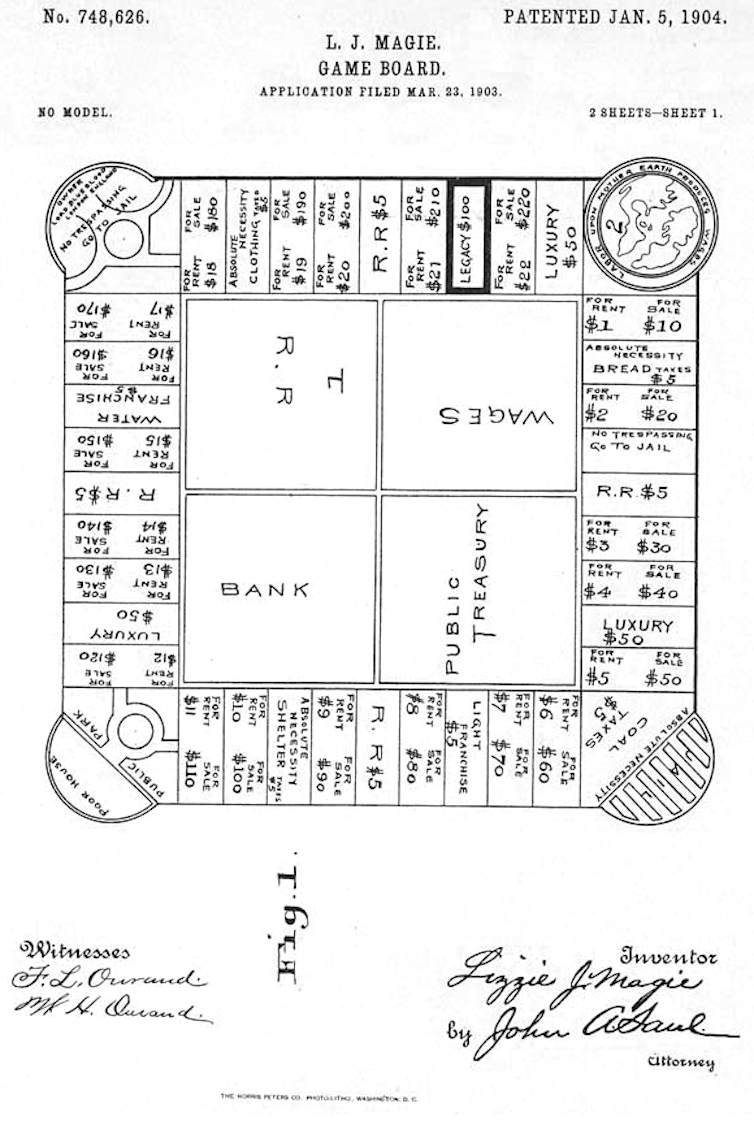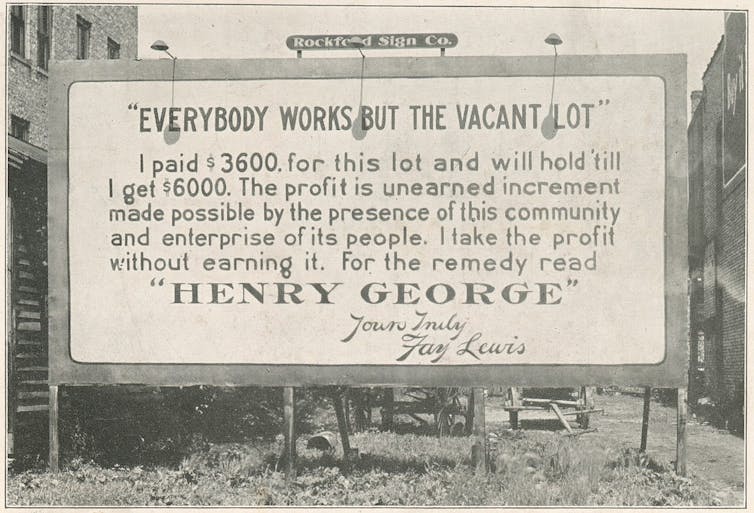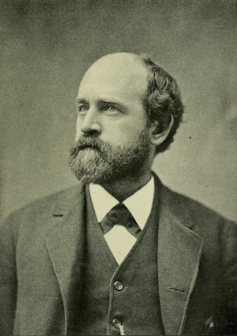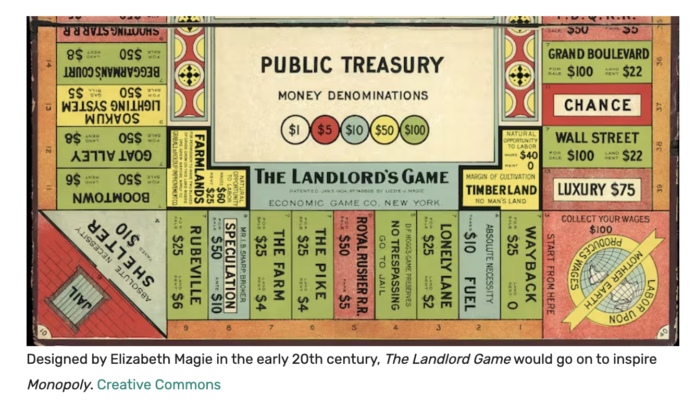How Monopoly informs academia and economics, even when it’s not obvious
By Thomas Michael Mueller, Université catholique de Louvain (UCLouvain)
At the top hat’s turn to roll, the dice land on ‘Chance’ and it’s a one-way ticket to Mayfair. Aged just ten years old, I won my first game of Monopoly, but I strangely didn’t feel a sense of joy. I was rich, very rich indeed. But I was the sole proprietor of the houses, hotels and lots left behind by a fictional society of which I was the last remaining survivor.
Perhaps even back then, I suspected that the true lesson of Monopoly was that capitalism (in its most radical form) would lead most of us either to solitude, if we were lucky, or to bankruptcy, if we weren’t.
And this is exactly what the game’s creator was trying to tell us all along.
The birth of Georgism
At its inception, in 1903, the initial version of the game of Monopoly, which was then called The Landlord’s Game, was intended as a warning against the ills of capitalism. Just like in the modern version, players would play until the last card was drawn and the last hotel was placed.

Unlike its current format, however, the original allowed two jaded and frustrated players to team up against this brutal social experiment. They could revolutionise the game-play by setting alternative rules such as nationalising the bank, converting the jail into a school or giving all stations free state access to water and electricity. But don’t be fooled; this was in no way a proletarian revolution, as all players remained the individual proprietors of their hotels, houses and assets in a sort of balance between state-run and private property.

Although now largely unknown, this utopian model was once popular in the United States under the name of Georgism. The movement advocated a world where individual success and the American dream could be achieved as tangible, real concepts, while countervailing state power would prevent the emergence of large monopolies and help redistribute wealth. Georgism supported the idea of a single tax on land, minerals and inheritances, which would allow us all to reap the fruits of our labour and do away with unearned income. This brings us neatly to our household game, which strove to show how monopolies would generate misery and poverty, whereas opposing models of economic management would ensure well-being and prosperity for all. In the Georgist world, winning the game meant getting rich without causing others to go bust.

Elizabeth Magie: social justice pioneer
The Landlord’s Game was the brainchild of the much-unsung Georgist activist and feminist Elizabeth Magie, whose story is chronicled in The Monopolists by American journalist and author Mary Pilon. The book tells how Magie was never able to enjoy the rewards of her ingenious creation and how her name was lost to the annals for decades. Although Magie’s game did not sell well and was poorly promoted, it was met with avid acclaim from those who shared her Georgist ideals. As the game spread along the East Coast, activists and fans copied the model and passed on the rules by word of mouth, playing in university dorms, parks, smoking rooms and even in the lecture hall. Magie’s game bore many names on its journey to becoming the now-familiar Monopoly.
This game made tangible comparisons between capitalism and Georgism, using the material forms of wealth, banknotes and assets. We can only guess at how many young minds of Princeton and Columbia might have experienced this new rhetoric of numerals, but we know for sure that one of them was Harold Hotelling. A gifted statistician, outstanding economist and devotee of Georgism, Hotelling went on to become the thesis advisor of two Nobel Prize winners.
Hotelling enjoyed playing Monopoly with his family, with students, and even alone at night before succumbing to sleep. His chosen version was, naturally, the original Georgist one. Eventually and no doubt subconsciously, he began incorporating the game into his later-renowned economic models. Following a consistently similar writing structure, Hotelling’s articles dealt with subjects as disparate as taxation, non-renewable resources, geographical economics and social welfare.
Hotelling’s social optimum
Firstly, Hotelling defined a model for society and proposed to study the effects that capitalist policy would have on it. He then compared these potential effects with those offered by alternatives such as socialist management. The resulting blend was what he coined the “social optimum”, his choice of policy that would help achieve the best for society as a whole.
Aspects for us to optimise always depend on the issue at hand, whether this be maximum well-being, more efficient geographical distribution or optimal exploitation of resources. But regardless of topic, Hotelling’s models consistently drew correlations between the social optimum and Georgist policy. To be clear, Hotelling never actually wrote of “Georgism” in his articles, instead concealing his ideology behind rigorous mathematical proofs. He expressed his ideas by describing ever-accumulating sums of money, leaving aside everything except solid logic and discussing it all in terms of social welfare. However, an ingeniously playful theme runs through his articles, whereby he compares various social utopias by replicating them into the microcosm of the board game.
Driven by a tireless thirst for knowledge, Hotelling rose through the ranks of American academia and eventually achieved international renown. The apex of his career as an economist came in 1938 when he turned his attention to natural monopolies, referring to those that make any form of market competition nigh on impossible. These economic phenomena usually occur when initial investment costs are so high that it is extremely difficult and ultimately infeasible for two companies to invest and compete. Some examples are rail transport, electricity and drinking water. Yes, these are the very same companies present on the Monopoly board and no, this is not a coincidence.
Using some clever calculations to compare the level of well-being that would be created by different social models, Hotelling managed to demonstrate how much train tickets, drinking water and electricity would need to be subsidised in order to service the common good. Again, he drew comparisons between capitalist society and his social optimum. And again, the ideas of Elizabeth Magie became reincarnated as an economic model.
A flourishing hypothesis
Hotelling’s writings from 1938 on natural monopolies met with unexpected success. In France, after a turbulent discussion that culminated in a profound friendship with Hotelling, economist Maurice Allais used the idea to support a cogent political argument to change the face of French power and rail management. Meanwhile across the Atlantic, Nancy Ruggle (another researcher whose work deserves more visibility) and a handful of other economists were gradually transforming Hotelling’s concepts into what we now know as the second theorem of welfare economics.
It was also because of Hotelling that one of Allais’s students, Gérard Debreu, came to the United States and brought a new topological angle to the issue at the heart of Hotelling’s 1938 idea. Debreu’s theories were fed by the ever more complex and impassioned debates that he was privy to with Hotelling and Allais. He later applied his method to what is now arguably the most celebrated economic theorem, the Arrow–Debreu model. Kenneth Arrow, a talented student of Hotelling’s, also took his teacher’s social optimum concept further and won a Nobel Prize for it. Another of Hotelling’s protégés was Will Vickrey, who also won a Nobel Prize and expanded on a number of his teacher’s ideas.
Although Hotelling was likely unaware of the existence of Elizabeth Magie, he never stopped playing Monopoly. To this day, the popular board game continues to hide references to a number of economic models, while Georgist ideals have found their way into modern economics under the guise of “social optimum”. So, Monopoly is celebrated and referenced every day by economists and academics the world over. Some will have no knowledge of Magie and her game, nor the teachings of Georgism. And yet, the game continues to creep unnoticed into their research, textbooks and lectures.
Translated from the French by Enda Boorman for Fast ForWord![]()
Thomas Michael Mueller, Maître de conférence HDR en histoire de la pensée économique à l’Université Paris 8, Université catholique de Louvain (UCLouvain)
Top image: designed by Elizabeth Magie in the early 20th century, The Landlord Game would go on to inspire Monopoly. Creative Commons
This article is republished from The Conversation under a Creative Commons license. Read the original article.



